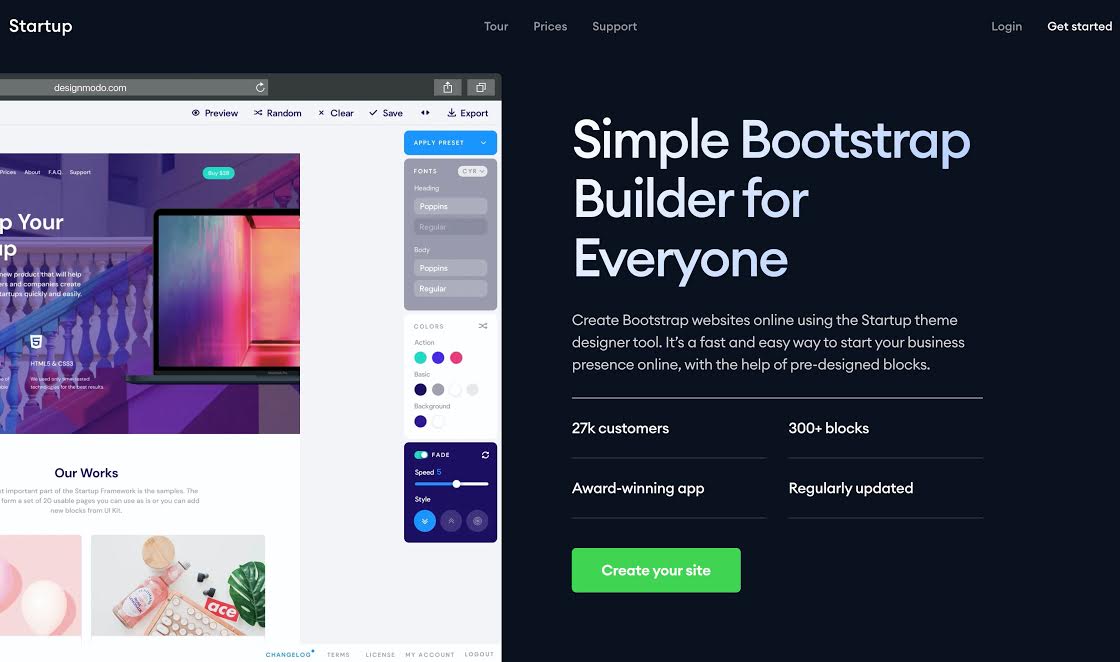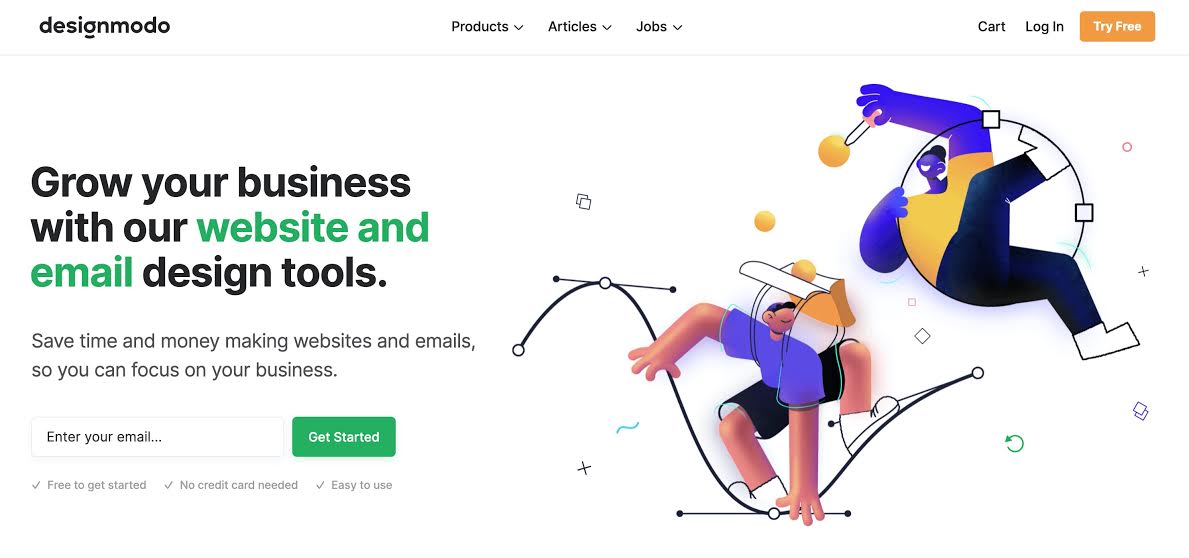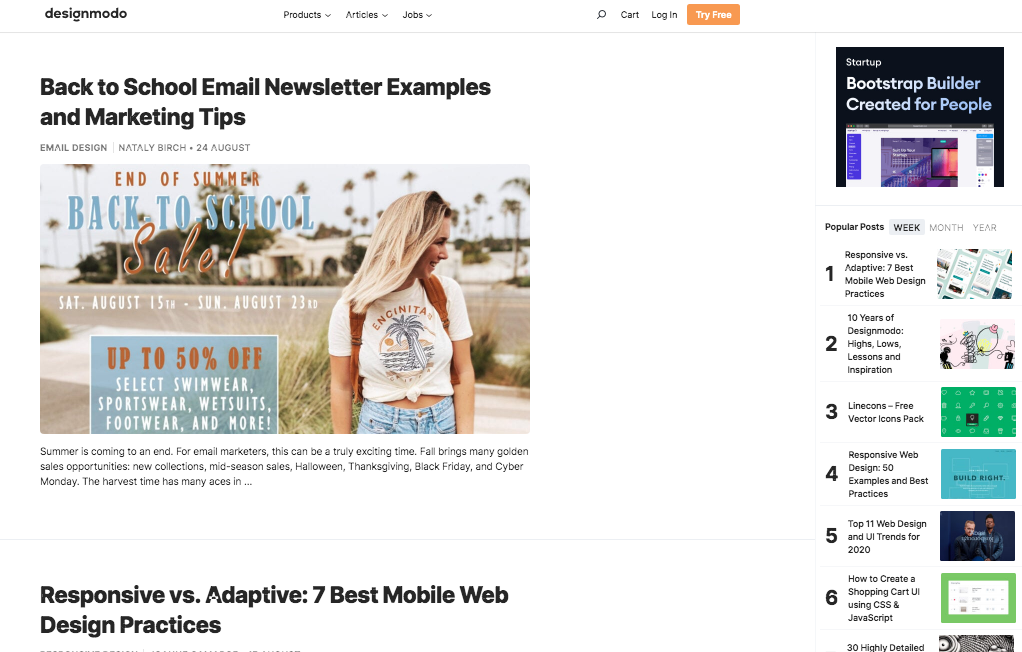How Profit-Sharing and Reinvesting Helped My Business Grow to $40k MRR
Hello! What's your background, and what are you working on?
Hey! I'm Andrian Valeanu and I'm founder of Designmodo. I've also founded a few other small side projects that have succeeded, as well as a few more that have failed.
I don't have any tech education, but I always had a big interest in technology and the internet. I started to learn SEO, design, and coding seventeen years ago by watching and reading tutorials. I created my first website around that time; it was the first forum and online magazine for metal and rock fans from my country, Republic of Moldova. Then, about four years ago, I left for Barcelona, Spain.
At Designmodo, we develop tools for building websites and email newsletters. In 2020 we expect to earn $500k-$1M ARR, and we continue developing our apps and scaling our business. The bulk of the revenue comes from subscriptions.
What motivated you to get started with Designmodo?
Ten years ago, I was motivated to create something that would allow me to leave my day job and dedicate 100% of my time to my own project. In my country, salaries are very low, and I was only earning $350 per month. So as soon as I began earning $350 per month from my project, I left my main job.
During that period I focused on growing the project’s user base and testing different business models. I saw rapid growth between 2012 and 2016, but then, when a couple of projects didn’t work, we had a revenue crash. Thankfully we later recovered from that crash!
We pivoted to sell design assets and web templates, and now we have a SaaS business with thousands of active subscribers. This is our main business, and we’re competing with big players in the market who receive investments and mentorship support. We do all our work in-house, and we’ve never received any external support, which makes us all the more proud of our success!
What went into building the initial product?
I had almost no budget at the outset, so I began to search for partners who were open working with me on a revenue-share basis. Now we work on shared revenue with almost all of our team.
The initial products had minimal functionality. At the beginning, what set us apart from our competitors were our designs. We put a lot of time and effort into them. During the product-development phase, we maintained a high design quality and also improved the code and back-end functionality.
We're an indie company and all of our revenue comes from sales. We invest our own money into the business too, so we closely analyze all spending and try to release new features as quickly as possible... ideally ahead of our competitors!
Our first product was created in just one month. Now, we spend between six and nine months developing each MVP ahead of their first releases.
What's your tech stack?
We started with WordPress. Later we integrated WooCommerce (for billing and CRM) and subscriptions.
Applications we use include Bootstrap, jQuery, Vue, React, and a couple of other modern technologies. To design our apps and our website we use Figma, but we used Sketch in the past.
We customize the frameworks, plugins, and third-party services we use in our work. These are serious technical changes which offer us flexibility. And when the creators update these technologies, we make sure our customizations are compatible with the new versions.
How do you approach these customizations?
In the first place, we only use technologies that permit us to make changes. Then we go through the standard product-development cycle:
- We plan the needed functionality with our developers, and the developers make the changes.
- After testing the functionality, we release the new code to production.
Sure, there are many moments when we understand the released feature is not enough, and in those cases we roll back the changes and work on code improvements.
How have you attracted users and grown Designmodo?
We attract users and grow Designmodo primarily with our blog, where we have more than 1,000 published articles. A few of our most popular free content pieces are responsible for most of our growth.
We've also created design assets that generate lots of links and good traffic from very popular resources. These links converted our domain into a high-authority website, so then we ranked higher on search engines too. If you check the backlinks to our domain name, you’d be surprised at the quality of sources who link to us.
Wev'e tried paid ads too, but haven't found a way to turn a profit from them. Can anyone help us?! 😅 So we don't use paid ads now, although we’re sure there’s a way it can be done.
How long did you experiment with paid ads, and when did you know it was time to give up on them?
We've tried them a couple different times. In 2014, we spent much of our budget on ads, but with no results. In 2019 we tried again to test the paid ads on subscription-based models. We saw some ROI from this, but not enough to cover the costs.
So we decided that the best investments were our products themselves. And now we spend all of our money developing new products and improving functionality, instead of on ads.
What's your business model, and how have you grown your revenue?
Our business model is SaaS. We offer monthly, quarterly, and annual subscriptions. For payment we use PayPal and Stripe. Stripe processes upwards of 60% of the revenue. We have increased our revenue by introducing subscriptions, while originally we offered one-time payment products only.
The expenses we have now are related to product development, organization, and design. I recommend all digital creators to try out the subscription business model, because it gives the clearest estimation of your future revenue, and data with which you can plan investment in your product, and potentially attract outside funding too.
These days we use a slow-grow approach. We don't have any external investments and our growth is entirely organic. We expect to continue this growth this autumn when we'll release a number of app updates. Hopefully these updates will be effective in building loyalty with existing users and also attracting new ones.
What are your goals for the future?
Right now, our primary goal is not revenue, but to continue the next set of updates across all of our apps so they’re entirely no-code ready. The Postcards app, for example, is already a no-code tool for newsletter creation. We now need to update the Slides and Startup apps, so they’re also 100% no-code. Then we'll start to add more integrations and features for our apps.
Our second important goal is to boost our traffic from search engines, as they are an important revenue driver. That means working on our website and content.
And thirdly, thinking to our revenue, we'll feel more comfortable when we reach a $2M ARR. This gives us enough to invest more in our people and product development.
Regarding my own personal goals, I'm working on other projects and I hope to release three this year. The entire team is working hard to make it possible this autumn. These other projects are related to:
- No-code website builder for designers
- Email marketing
- Hosting
I'll talk more about these projects in another of my articles here on Indie Hackers.
If you had to start over, what would you do differently?
As I mentioned earlier, from the very beginning of the project we continuously reinvested the money we earned. So we once tried investing in developing a new product, this time for WordPress. It was a bad decision and a valuable learning lesson.
After the Startup app release, people had asked for a WordPress theme based on that. Sounds like a good idea, right? We gave it some thought. “Let’s do this!” we said.
We hired a few WordPress developers and started to work on the Startup WordPress theme. The first release of the theme failed, but we still had revenue from previous products, so we decided to continue working on the theme and make it better.
We covered all our spending with our sales for a few months, but then sales began to fall.
Our solution to save the project? “Let’s FAIL AGAIN!” We started work on a WordPress (again!) plugin called Qards. No luck with this plugin either.
In 2016-2017, we stopped developing WordPress products and started to pay off the debts we’d built up with previous developers. We continued to fix bugs on previous products and offer support for clients. We were paying everything we needed each month, over the space of a year.
We continued publishing articles and tutorials, offering support, and fixing bugs. We had to cut a large part of the project budget, but we continued to post new content.
We lived from our savings. We lost a part of the team. Only three of us remained: Sergey, Edvard, and me.
So, what did we do wrong?
- We hired too big a team to get the work done quickly.
- We targeted an industry (WordPress) that we weren't familiar with and didn’t understand, and started the project without any expertise.
- We managed our money poorly, without analysis of past and expected sales.
- We developed every product and feature users suggested without considering the business case for doing so.
- We only thought about acquiring new users, not retaining them over the long term.
How do you motivate yourself after a loss like that?
In my case, after a failure, I need just a few days to recover. Normally, I don’t conclude that the project failed on the same day of release. I try to promote them, improve the functionality, and only after a few months or years, comes the moment when I realize the fail and I stop.
By stopping, I mean: shut the project down or sell it. If I can’t sell it, I shut it down. So, my motivation is selling the project, and if I can’t sell it, my motivation is that I have more time to dedicate myself to a new project. No time to cry.
What's your advice for indie hackers?
My general advice is to try to do something, and don't be afraid to fail. You don't fail if you try to do it. You fail if you don't try it at all.
Also, I can suggest some other things. If you’ve really got faith in your business, put your profits into it as well as your heart.
No matter how challenging a situation may seem, there’s always a solution if you think creatively and have the ability to learn from failures. Maybe that means developing a new idea or abandoning an old one. Maybe it means collaborating with people in new ways. Just don’t let it get you down.
Building a supportive community can pay higher dividends than you could ever imagine.
Focus on what you know. Innovate, sure, but don’t try to crack a new market if you don’t know what you’re doing.
Don’t rush to turn each and every suggestion into reality; take time to work out which ones are worth pursuing and which aren’t.
Building a solid team is one of the most important elements of product development. You can start solo, but if you want to grow, if you want your idea to become a reality quickly, you need a good team with ambition and dedication. The team should be professionals with good organization and the right skills. Every team member should help power the engine driving the project forward, without needing to be pushed by others.
Where can we go to learn more?
You can learn more about Designmodo here. On social media you can find me on LinkedIn, Twitter, and ProductHunt.
If anyone has any questions for me or the team, please don't hesitate to ask in the comments. I'll try to answer anything/everything you need to know.
Thank you Indie Hackers!



